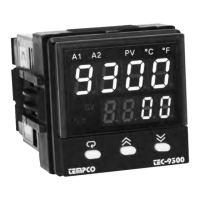37
3–19 Auto tuning
The auto-tuning process is performed at the set point.
The process will oscillate around the set point during the
tuning process. Set the set point to a lower value if overshooting
beyond the normal process value is likely to cause damage.
Auto-tuning is applied in cases of:
• Initial setup for a new process
• The set point is changed substantially from the
previous auto-tuning value
• The control result is unsatisfactory
Operation:
1. The system has been installed normally.
2. Use the default values
for PID before tuning.
The default values are: PB1=PB2=18.0°F
TI1=TI2=100 seconds, TD1=TD2=25.0 sec-
onds.
Of course, you can use other reasonable values
for PID before tuning according to your previ-
ous experiences. But don’t use a zero value for
PB1 and TI1 or PB2 and TI2, otherwise, the
auto-tuning program will be disabled.
3.Set the set point to a normal operating value or
a lower value if overshooting beyond the normal
process value is likely to cause damage.
4. Press until appears
on the display.
5. Press for at least 3 seconds. The upper
display will begin to flash and the auto-tuning
procedure is beginning.
NOTE: Ramping function, remote set point,
or pump function, if used, will be disabled
once auto-tuning is proceeding.
Procedures:
Auto-tuning can be applied either as the process
is warming up (cold start) or when the process
has been in a steady state (warm start). See figure 3.22.
If auto-tuning begins apart from the set point (cold start), the unit
enters warm-up cycle. As the process reaches the set point value,
the unit enters a waiting cycle. The waiting
cycle elapses for a double integral time (TI1 or
TI2, dependent on the selection, see section
4.1), then it enters a learning cycle. The double
integral time is introduced to allow the process
to reach a stable state. Before the learning cycle,
the unit performs a pre-tune function with PID
control. While in the learning cycle, the unit
performs a post-tune function with an ON-OFF control. The
learning cycle is used to test the characteristics of the process.
The data is measured and used to determine the optimal PID val-
ues. At the end of the two successive ON-OFF cycles, the PID
values are obtained and automatically stored in the nonvolatile
memory. Once the auto-tuning procedures are completed, the
process display will cease to flash and the unit will revert to PID
control using its new PID values. During the pre-tune stage the
PID values will be modified if any unstable phenomenon which
is caused by incorrect PID values is detected. Without the pre-
tune stage, like other conventional controllers, the tuning result
will be strongly related to the time when the auto-tuning is
applied. Hence, different values will be obtained every time auto-
tuning is completed without pre-tune. It is particularly true when
auto-tuning is applied using cold start and warm start.
If auto-tuning begins near the set point (warm start), the unit
skips the warm-up cycle and enters the waiting cycle. Afterward,
the procedures are the same as described for cold start.
Auto-Tuning Error
If auto-tuning fails, an ATER message will appear on the upper
display in the following cases:
• If PB exceeds 9000 (9000 PU, 900.0°F or 500.0°C);
• if TI exceeds 1000 seconds;
• if the set point is changed during the auto-tuning procedure;
• or if the event input state is changed so that the set point
value is changed.
Solutions to
1. Try auto-tuning again.
2. Don’t change the set point value during the auto-tuning
procedure.
3. Don’t change the event input state during the auto-tuning
procedure.
4. Use manual tuning instead of auto-tuning. (See section 3-20)
5. Touch any key to reset message.
Pre-tune
function
advantage:
Consistent
tuning results
can be
obtained

